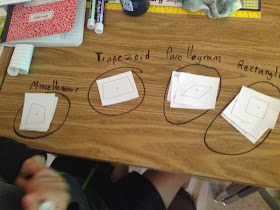I started out by using an activity provided in our Georgia math frameworks from our district to introduce quadrilaterals. Each student received 12 numbered cards containing quadrilaterals on them. Once each student cut out their cards and looked at them, I had them work in their teams to try and come up with a way to group them. They were able to write on their desks to help organize the cards and label each of the different groups.
I was very surprised to see all of the different ways that each group decided to classify their quadrilaterals. Here are what some of the desks looked like:
<----- This student grouped them by "type" (trapezoid, parallelogram, rectangle, and miscellaneous)
<----- a grouping based on whether the polygon was regular or irregular
<----- a grouping based on the amount of parallel lines
<----- classification based on the types of angles
One thing was certain in this activity - everybody had a different idea on how to classify the shapes. I had each group of students rotate around to the other groups to look at the other students' ideas and had them share what surprised them or intrigued them.
After this portion of the activity, I handed the students a chart from our frameworks that contained 6 terms: quadrilateral, square, rectangle, parallelogram, rhombus, and trapezoid. Under each term was a list of the criteria for a shape to be classified under that term. Some of the categories were # of sides, #of angles, # of congruent sides, # of congruent angles, presence of parallel lines, etc. I had my students arrange all the numbered cards on their desks and we started with "quadrilateral". We went down the list of attributes for the shape and turned over any cards that did not fit all of the criteria. For this term, they realized that every card was a quadrilateral.
Next, we moved onto square and turned over all of the cards that did not fit the square attributes and continued in the manner. They began to see how certain shapes fit into the category, and how some don't. It was also a great way to review the terms "parallel" and "congruent".
Tomorrow, in continuing with quadrilaterals, we will be finishing up the classification of the rest of the 6 terms in the list. I will also be giving my students a Venn diagram in which they will choose two quadrilaterals to compare and contrast using the attributes that they have learned about in the first activity.
I will be sharing some other activities that I plan to use as we continue through this unit, including a quadrilateral project. I would love to hear of any feedback you have or ideas on how else to teach the classification of 2D figures.






I must have missed this, but I have to ask, "How are your students writing on their desks?" We use slates all the time but I love the idea of being able to use the surface of the actual desk. I also wanted to let you know I nominated your blog for a Liebster Award. You can check out the nomination HERE
ReplyDeleteStacy,
DeleteMy students are writing on their desks with Expo markers. It makes the desk a tad messy, but they absolutely love it. I have them use socks as erasers and then when we're completely finished with it, they use a wet wipe to clean it really well.
Terry